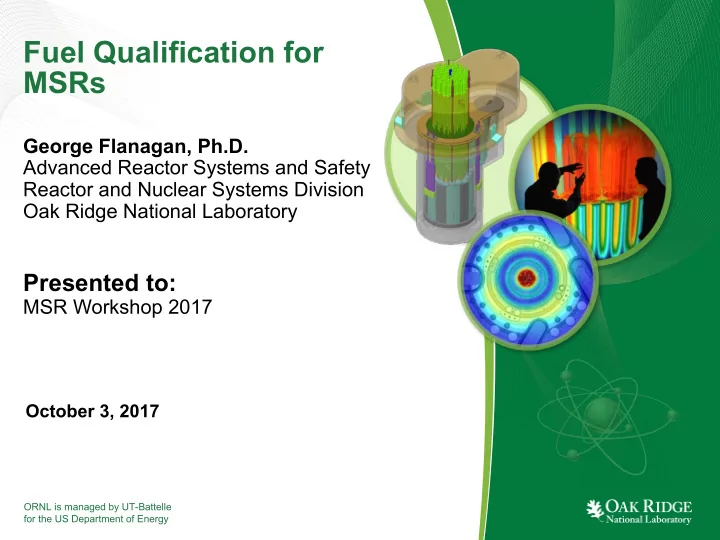

Fuel Qualification for MSRs George Flanagan, Ph.D. Advanced Reactor Systems and Safety Reactor and Nuclear Systems Division Oak Ridge National Laboratory Presented to: MSR Workshop 2017 October 3, 2017 ORNL is managed by UT-Battelle for the US Department of Energy
Fuel Qualification Needs to be Defined for MSRs • Fuel Qualification – Traditional – For heterogeneous reactors the fuel/cladding system is the principal barrier to release of fission products – Extensive effort has been placed by the industry and NRC on assuring that the behavior of the fuel is well understood under all perceived operational conditions (including AOOs and postulated accidents) ⟺ fuel qualification • Heterogeneous fuel performance is substantially impacted by radiation and temperature history • Liquid fuel has no history effects (accumulated stress, creep, swelling, etc.) beyond changes to chemical composition – Includes extensive irradiation and hot cell examinations 2 Fuels Qualification for MSR, August 3, 2017
Fuel Qualification Needs to be Defined for MSRs (cont.) • Fuel Qualification – MSRs – Have no equivalent to the traditional fuel qualification process – MSRE indicates that fluoride salt compounds are insensitive to irradiation damage – Chloride salts still need irradiation data – Major concern will be changing chemical behavior during residence time in the reactor and in storage – In MSRs the fuel is also the coolant • Changes in chemical composition may change the thermal/hydraulic properties of the salt and thus impact the safety case – Issue: there are no regulatory precedents for identifying the controlling parameters that need to be addressed in the MSR fuel qualification 3 Fuels Qualification for MSR, August 3, 2017
Fuel Qualification Needs to be Defined for MSRs (cont.) • Fuel Qualification – MSRs – Properties are generally known for pure fuel salts at beginning of life – Properties are not well known for salts containing corrosion products, fission products and minor actinides as a result of irradiation (outside of MSRE) – Need fuel performance modeling with data benchmarks (may not require irradiated materials) – NRC must be involved to assure that information generated is adequate and complete – Appropriate quality assurance must be applied 4 Fuels Qualification for MSR, August 3, 2017
Fuel Qualification Needs to be Defined for MSRs (cont.) • Fuel Qualification – MSRs – Need for basic information to be generated to assure that all parameters associated with fuel salts that can affect safety or operations are understood (impurity limitations/cliff edge effects) – Simultaneous Fuel Performance Specification • Radionuclide retention (source term) • Container attack (fission makes fuel salt more oxidizing) • Progressive degradation of heat removal capabilities and restoration via chemistry control system – Density – Boiling point – Melting point – Viscosity – Thermal conductivity – Heat transfer properties • Fissile material plate-out • Solubility (fuel, actinides, fission products) 5 Fuels Qualification for MSR, August 3, 2017
Safety Implications of These Changes Need to be Determined • Not all possible chemical compositions need to be explored • Need to determine which parameters are important to the safety case and degree of variability allowed • This might be considered to be a chemical version of the Specified Acceptable Fuel Design Limits (SAFDL) as described GDC 10 in Appendix A of 10CFR50 • Cladding as a principal fission product barrier is included in current heterogeneous fuel qualification program – For MSRs the reactor vessel and associated piping is covered by ASME standards – Thus, only the fuel itself needs to be considered in the MSR qualification process 6 Fuels Qualification for MSR, August 3, 2017
A Possible Approach • In submitting an application, the applicant has assumed certain properties of fuel/coolant which are then used in the safety analysis in order to meet the regulatory requirements • This set of data form the basis for the determination of the parameters impacting the safety case • Sensitivity studies can be used to determine the limiting values for these properties, that if exceeded, could result in a plant exceeding the safety envelope – Not only thermal hydraulic properties need be considered, but other properties such as • Solubility of fission products in the salt which might impact the source term • Plate out of radioactive material or solubility limits assumed for the fuel 7 Fuels Qualification for MSR, August 3, 2017
A Possible Approach (continued) • Once the important parameters are identified, experimental measurements and data can be developed to indicate the impact of salt composition on the important parameters • Major drawback is the variability of salts being proposed by various designers • Chloride salts need irradiation data to confirm their stability in reactor environments 8 Fuels Qualification for MSR, August 3, 2017
Qualification of MSR Fuel May Be Less Expensive and Time Consuming than Current Heterogeneous Fuel but Still Will Require Significant Expenditure of Resources • No irradiation • No hot cell examination • Can be accomplished without radioactive isotopes. May use natural U and surrogate for Pu (chemical behavior not dependent on isotopic composition) – Only chemically insignificant quantities of trans-plutonium elements anticipated • Small samples (special effects tests) / no geometric requirements • It is necessary to define a process that meets the regulatory requirements before DOE or Industry can establish the R&D needs 9 Fuels Qualification for MSR, August 3, 2017
Recommend
More recommend